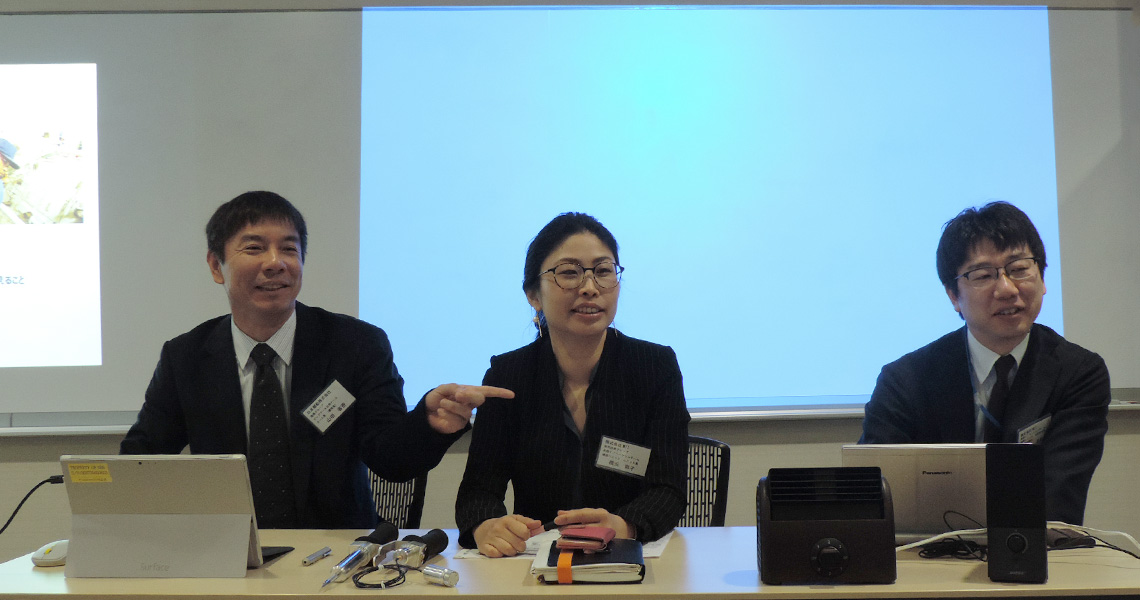MTI Journal
MTI Journal.06
Aiming for an Open Innovation on Marine Engine Plants
Ayako Hashimoto
Principal Researcher, Maritime Technology Group*
*The job title is as of August 15, 2018
I was seconded to MTI in April 2015 and have worked on the development of new technologies for predicting the conditions of vessel plants and the component machinery’s remaining useful life (RUL) assessments.
In 2005 I joined NYK as a technically oriented employee. After having worked in the technology division managing newbuildings and in-service ships, I twice took maternity leave, so this is the second time to work at MTI. The first time occurred in a kind of bubble era for developing technologies for energy-saving and environmental measures that could cut CO2 emissions from ships and save fuel consumption. Now, this second time, while utilizing those energy-saving technologies, I enjoy the development of systems and tools for the remaining useful life (RUL) assessments that can predict the future state of a marine engine plant as one of the main elements of ships. In other words, those technologies should be able to judge whether the current state is normal or abnormal and indicate the performance degradation of the equipment, thereby enhancing the ship’s safety and reliability.
Importance of open innovation
The engine rooms of ships are filled with various kinds of machinery: for propelling the ships, for generating the electricity and steam needed for crew members’ accommodations, and for carrying and handling customers’ cargoes. I have worked on the development of systems and tools for obtaining the operational data from that machinery, analyzing the data, judging the condition, and thus predicting RUL assessments. But ultimately, it is quite difficult for MTI by itself to complete such a comprehensive R&D project. That is because various fields of expertise – in sensors to obtain the operational data of machinery, in information communication for sharing the data between ship and shore, in the design of machinery itself for judging the machinery’s condition and predicting the RUL assessment, and such – all must be fused.

During a media briefing (Center: Ms. Hashimoto)
Example of open innovation
As an example, there is a project that I have been in charge of since 2016: utilizing big data in developing a method for improving the safety and economic efficiency of marine engine plants. NYK, MTI, Japan Marine United Corporation, Diesel United, Ltd., Terasaki Electric Co., Ltd., Sunflame Co., Ltd., and Mitsubishi Kakoki Kaisha, Ltd. are involved in this project, and we have worked together on R&Ds on the below six themes.
1) Development of a method for diagnosing the condition of the inside of the cylinder liners of main engines
2) Development of a predictive diagnostic system for dry-heating auxiliary boilers
3) Development of a predictive diagnostic system for blackouts
4) Development of an optimal operation method of plants under slow steaming
5) Development of an advanced alarm system for data loggers
6) Development of a comprehensive operation-monitoring system for oil purifiers
In the open innovation with shipping companies, shipbuilders, and marine equipment manufacturers of main engines, switchboards, boiler burners, and purifiers, each company independently works for each theme. But a few times a year, all participants see one another and exchange information and their achievements, aiming to reduce high-risk incidents1 of engine plants by forty percent. This research has been carried out with support from the Ministry of Land, Infrastructure, Transport and Tourism’s “i-Shipping Operation” and as joint research studies with ClassNK, a general incorporated foundation.
What are user needs?
I explained the importance of open innovation first, but when conducting an open innovation, I think that what joint-research partners expect from MTI is to provide user needs. R&D projects matched with user needs are very likely to succeed and might lead to the possible development of best-selling products and solutions for joint-research partners.
One of the most important elements is user needs for proceeding an open innovation while creating win-win relationships between joint-research partners. MTI’s office is on the 7th floor of the Yusen Building, and all the research is conducted jointly with NYK. We have captains, chief engineers, navigation officers, and marine engineers at MTI, and it is relatively easy to get opportunities to visit the actual sites, vessels. Therefore, it is quite natural for partners to expect MTI to provide user needs. However, users don’t always have needs that lead to research projects, and it is very difficult to get real user needs for leading research projects to success. We must verify thoroughly if conducting R&Ds that dig into the real nature of needs and satisfy those needs can actually lead to merits for users and manufacturers. Thus, one of the most important jobs for MTI is to pull out real user needs.
Attitude needed to realize the open innovation
Open innovation is what NYK and MTI continuously aim to realize, and we hope to continue promoting collaborations with various partners. For that, we must always be sincere and honest with partners who mutually propose open innovation. In addition, we must let all partners know about and share in the fruits of the open innovation, ideally in ways that benefit all partners. I always ask myself why this open innovation is needed, and, in my own words, I hope to share the answer with related partners. What I cannot digest and tell stories about with enthusiasm cannot compel the partners. I must admit that I actually tend to forget that point because of my busy schedule and everyday work, but hopefully I would like to maintain that kind of attitude.
1. high-risk incidents:
Incidents that could lead to serious incidents, which cause a company huge economic and social damage, according to the sea area where such an incident occurs and the weather conditions, even if there is no downtime.
